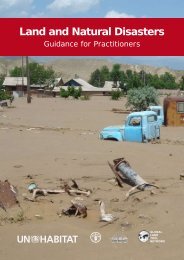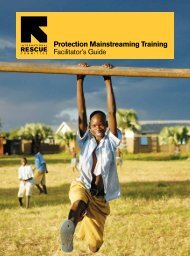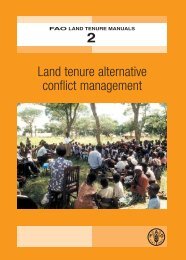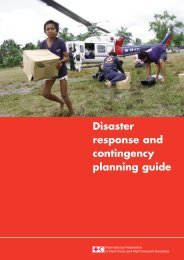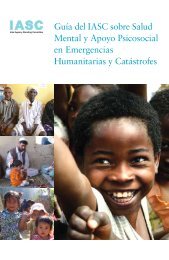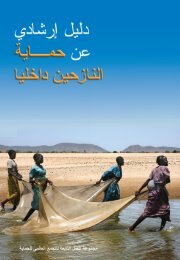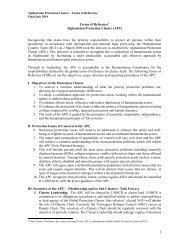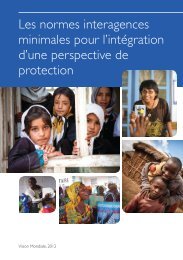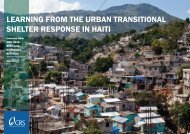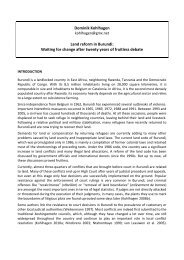Inter-Agency Real Time Evaluation of the Response to Cyclone Nargis
Inter-Agency Real Time Evaluation of the Response to Cyclone Nargis
Inter-Agency Real Time Evaluation of the Response to Cyclone Nargis
You also want an ePaper? Increase the reach of your titles
YUMPU automatically turns print PDFs into web optimized ePapers that Google loves.
3.10 CommunicationsLargely due <strong>to</strong> restricted access, public communications by <strong>the</strong> international community in <strong>the</strong> earlydays <strong>of</strong> <strong>the</strong> response was based on incomplete information. One result was that a number <strong>of</strong>international organizations rang <strong>the</strong> alarm about <strong>the</strong> threat <strong>of</strong> a massive second wave <strong>of</strong> deaths 12without a sufficient appreciation <strong>of</strong> <strong>the</strong> significance and effectiveness <strong>of</strong> <strong>the</strong> local response. Themedia spotlight has long since moved on<strong>to</strong> o<strong>the</strong>r news s<strong>to</strong>ries, but ano<strong>the</strong>r unfortunate result is that<strong>the</strong> prevailing erroneous perception outside <strong>the</strong> country continues <strong>to</strong> be that survivors were notreceiving humanitarian aid although, as described above, it is now clear this was not <strong>the</strong> case.One particular weakness <strong>of</strong> communications has been <strong>the</strong> lack <strong>of</strong> visibility <strong>of</strong> local efforts. Asrecommended in Aceh by <strong>the</strong> TEC studies, more prominence <strong>to</strong> local efforts in publiccommunications would have been, and continues <strong>to</strong> be, useful. However, at this point it is not clearthat sufficient media interest still exists outside <strong>of</strong> Myanmar <strong>to</strong> make such accounts newsworthy.3.11 PartnershipsOnce <strong>the</strong> IA RTE team had acquired a good understanding <strong>of</strong> <strong>the</strong> context, it was difficult <strong>to</strong> imaginehow international agencies could have mounted a humanitarian response <strong>of</strong> such a scale in <strong>the</strong>absence <strong>of</strong> ASEAN and <strong>the</strong> TCG. While a handful <strong>of</strong> international organizations were alreadyoperating in <strong>the</strong> Delta within days, <strong>the</strong> sustained large-scale response that unfolded requiredsignificant changes in government policy and attitudes for which ASEAN’s role, supported by <strong>the</strong>UN and o<strong>the</strong>r agencies, was perceived by virtually all international stakeholders as critical inbringing about this transformation .From meeting minutes and interviews it is clear that <strong>the</strong> TCG continues <strong>to</strong> play a vital facilitationrole in maintaining humanitarian space, a role appreciated by all international agencies. Since itsestablishment on 31 May, <strong>the</strong> TCG has emphasized this facilitation role and has minimizedinvolvement in policy issues, an approach which appeared <strong>to</strong> be one <strong>of</strong> <strong>the</strong> keys <strong>to</strong> its success. Asdescribed above, <strong>the</strong> PONJA (and presumably <strong>the</strong> upcoming Periodic Review) not only resulted inuseful assessment data, but had <strong>the</strong> effect <strong>of</strong> streng<strong>the</strong>ning relationships between <strong>the</strong> government,ASEAN and international agencies.While <strong>the</strong> TCG and PONJA process were effective at building bridges with <strong>the</strong> government,international agencies have been facing a number <strong>of</strong> challenges with building partnerships with localorganizations. Minutes from a national NGO “reflections” meeting held during Oc<strong>to</strong>ber note thatcoordination mechanisms set up by <strong>the</strong> international community are not meeting <strong>the</strong> objective <strong>of</strong>working better <strong>to</strong>ge<strong>the</strong>r. Particular obstacles <strong>to</strong> full participation cited by local agencies included <strong>the</strong>use <strong>of</strong> English as <strong>the</strong> almost <strong>the</strong> sole way <strong>of</strong> communicating, facilitation style, meeting structures,and <strong>the</strong> way agendas are established. A recommendation targeted at international agencieschallenged <strong>the</strong>m <strong>to</strong> explore different ways <strong>of</strong> partnering with local groups and communities so thatlocal capacity can be supported and built without making such heavy demands on <strong>the</strong>ir time. Thiswas consistent with a number <strong>of</strong> interviews <strong>of</strong> national NGO staff who referred <strong>to</strong> <strong>the</strong> relatively‘unfriendly’ cluster system, along with <strong>the</strong> opinion that many national ac<strong>to</strong>rs (particularly NGOs)have been left out <strong>of</strong> important planning processes.12 See, for example, <strong>the</strong> 10 may 2008 Reuters release entitled, “Slow Myanmar aid raises health risks for survivors”available via http://www.reliefweb.int/rw/rwb.nsf/db900sid/EVOD-7EHGQA?OpenDocument&rc=3&cc=mmr.25



